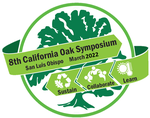#52

Bark Properties and Expected Conferred Resistance to Fire-induced Mortality in Three California Oak Species
Kaili Brande, Bren School of Environmental Science and Management, University of California, Santa Barbara
Frank W. Davis and Bruce Kendall, Bren School of Environmental Science and Management, University of California, Santa Barbara
Problem:
As fire is returning to California ecosystems at a rapid pace, understanding the natural defense mechanisms that oaks have is increasingly important. Bark is considered to be critical in protection against fire-induced embolism of the cambium. However, bark traits of California oak species have been rarely studied. To address this gap, we evaluate bark thickness and rugosity to better understand the role they play in fire resistance for three dominant oak species in Southern California foothills: coast live oak (Quercus agrifolia), valley oak (Quercus lobata), and blue oak (Quercus douglasii). By identifying differences across size and species, and assessing allometric growth patterns of each trait, we can better estimate conferred fire resistance, and create predictions of vulnerability at the stand level to inform management decisions.
Methods:
We collected data for all three species at Sedgwick Reserve, a unit of the UC Natural Reserve System. Samples were collected across a range of sizes and at two measurement heights along the trunk. Patterns of variation in the two bark traits will be analyzed by species. The allometric growth patterns of each trait will be evaluated using OLS regression, and differences between measurement heights will be evaluated using a mixed effects model.
Results:
Preliminary analyses suggest that mean rugosity values are more similar for valley and blue oak, than for coast live oak. We expect that bark thickness will also be most different for coast live oak, given prior visual assessments. We hypothesize that, based on allometric growth patterns and differences between measurement heights, the bark of all three species will suggest high conferred fire resistance.
Recommendations:
With climate change and a changing fire regime in Southern California foothills, oaks are expected to experience fire at a greater frequency and intensity. Understanding the bark traits of resident species and how they may aid survival will be critical for oak woodland managers in the coming decades.
